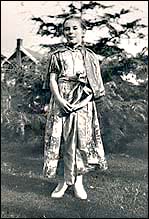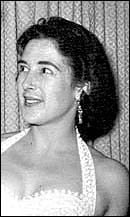A poet who makes the 1940s and 1950s in New Zealand come alive
Dorothy – 29/03/02
How did these poems come into being? To quote Lee’s own words: “I was talking with some primary school children about writing poetry. I wanted them to find some of the poems they had inside themselves. Everyone has at least a poem or two there. Of their very own. So of course they wanted to know what my very own poems were …. when I was their age! Trust them! I didn’t write poems when I was nine so I thought about some of the things that were different then. I wrote and took to the class:
|
Little Cleopatra 1941
I don’t remember Miss Allardice only her name and that she gave the strap to all the class for every spelling mistake when I was nine. Over in Egypt bombs were dropping on Bob my sister’s boyfriend and he couldn’t spell. He wrote us letters from At the Front. I corrected his spelling mistakes with a fountain pen full of red ink and I hoped he could hide in a pyramid. |
|
War efforts 1944
Mrs Moriarty went to the Red Cross on Wednesday afternoons to knit balaclavas and peggy squares for The Boys in Italy Little Moriartys raced home from school on Wednesday afternoons on a secret mission with a reason that was sweet rationed butter rationed sugar made the fastest toffee team Little angels doing homework when their mother came home Mrs Moriarty sniffed the halos in the air. Little devils. |
|
|
| Lee at the age she writes about in Little Cleopatra Photo source Lee Dowrick |
"It was a big hit with the class, and the School Journal published it. I wrote a couple more about my mother thinking my room was like a bombsite and putting ink into the boys’ inkwells before an arithmetic test. My own poetry workshop of grownups liked them too. They wanted more. So I found one of my old school photos, had it blown up to A4 and put it beside my desk. All those little kids looked so real. They hopped out of the photo and started to chat. Lots of the things we remembered turned into poems and soon there was a small book ‘That was Then 1935-45’. It’s fun. I wrote of ANZAC functions where the child’s perspective adds some touches of humour. They’re NZ history. They spark off other people’s memories.”
That was Then was published in 1998. Unfortunately there are no copies of that book available in the shops now – which is not surprising as they portray such a vivid picture of life for children in New Zealand during World War 2. The longing for sweets during the wartime rationing led to secret toffee making sessions while their mother was at Red Cross. That is the inspiration for:
Life away from home in the big city Lee Dowrick moved from Waipukurau to Auckland in the 1950s so she has firsthand impressions of a young country woman experiencing life in a bedsit in the big city, savouring her freedom and coping with the difficulties.
I run in my stilettos 2001 Lee brings us to the heart of life in the 1950s with her most recent collection of poems, “I run in my stilettos”. It’s an evocative title, especially for those who experienced the strong memories that stilettos evoke – a sense of wearing high fashion and painful toes at the end of the day – and a distressing legacy of damage to beautiful floors.
The cover is eye-catching and immediately conveys the period of the poems, with a black and white photo of the author as a young woman imposed upon a black and white aerial photo of Queen Street in the ’50s. Lee is looking around with a sense of wonder at the scene before her. The first poem in the book, “before the stilettos”, describes a newcomer’s awed exploration of Auckland city, map in hand, wearing “country flats”, and refers to “the scare of city trams”.
In the Queen Street photo on the cover there are several of the electric trams which feature in a number of the poems.
| I run in my stilettos to the tram stop on the corner from my bedsit and my gas-ring and a bath two nights a week jumping on the seven ten to meet my friend from her bedsit with her gas-ring and her bath two nights a week …. from Saturday night hop |
|
|
| Lee at the Arts Ball in the 1950s Photo source Lee Dowrick |
Trams feature too in after the dance is over where the partner from the dance has to cut short his goodnight kiss because he has to hurry to catch the last tram.
|
|
| Lee dressed to go dancing Photo source Lee Dowrick |
As I read I delighted in the number of evocative images that recalled life in the ’50s – a postie blowing a whistle and putting letters through the brass flap in the front door, a lumpy kapok mattress on ancient woven wiring, the butcher’s sawdust floor and large chopping block (part of “an ancient tree”), outside washhouses with copper and tubs, Lamson tubes taking change across the ceiling of the drapery shop, petticoats of taffeta rustling, swirling skirts, bony strapless bras and stockings with seams needing constant straightening.
Enormous enthusiasm for life Yet these poems are not just a collection of images of mid twentieth century life. They voice enormous enthusiasm for life, and the widely varied images are skilfully woven in and bonded with the dominant image of the stilettos. They stand for an emancipated life, independent adventures and appear in varied contexts – dancing at the weekend hops, watching the rugby and dancing at the after-match dances, working in a restaurant, being caught by the street photographer, shopping at George Courts for new stilettos, travelling on a train, “drowning underneath my bed” when the roof leaks. Cuban heels worn by a country friend who came to stay are the antithesis of high fashion and city living.
Deeper themes There are deeper themes underlying the buoyancy of the poems. Life in the bedsit on a small wage had its problems. This is the period when away from the inner city doors were left unlocked and children could play safely on the streets, but the other side of the picture is seen in a hot night in summer 1952 where two girls read Oscar Wilde to each other to stay awake because the glow of a prowler’s cigarette is seen in the garden and in the morning they find that their washing has been taken from the line. With an interesting juxtaposition of contrasted lives Lee comments that at the same time as the girls in the bedsits were keeping themselves awake the Queen was awake by the deathbed of King George VI.
In the inside people there is serious comment on the thwarted lives of women of an older generation conforming to society’s expectations with their dreams mothballed in the linen drawer.
There is also awareness of change. The girls hear that the trams are to be replaced by buses. The streets where bedsits abounded are changed and the draughty shabby houses are pulled down. On a train journey to the Wairarapa things are not as they were remembered. happily never after… portrays in a few lines how the giddy freedom of the single life is ended for some by stressful Catholic/Protestant weddings, and in when you lift up the lid of the Glory Box out fly the Birds and the Bees the single life is ended by engagement, marriage and life in a bungalow in a new subdivision.
As in all the poems Lee’s economical use of words and the choice of telling images create arrestingly vivid pictures.
Sharing her enthusiasm for poetry Lee continues to be very keen for children to experience the joy of writing their own verse and when she finds time she runs children’s poetry-writing workshops for them in a local school and in the holidays.
I run in my stilettos was first published in New Zealand in 2001 by Bookcaster Press Limited, PO Box 3765, Auckland.







